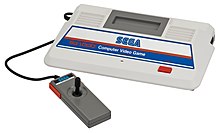
Back سيجا جيم 1000 Arabic اس جى-1000 ARZ SG-1000 AST SG-1000 Czech SG-1000 German SG-1000 Spanish SG-1000 Basque Sega SG-1000 Finnish SG-1000 French Sega SG-1000 Croatian
 | |
| Manufacturer | Sega |
|---|---|
| Type | Home video game console |
| Generation | Third |
| Release date | SG-1000/SC-3000
|
| Discontinued | SG-1000
|
| Units sold | Japan 400,000 (SG-1000)[1] 1.4 million (SG-1000 series)[2] 120,000 (SC-3000)[3] |
| Media | ROM cartridge, compact cassette, My Card |
| CPU | Z80 @ 3.58 MHz |
| Memory | 1 KB RAM |
| Display | 256 × 192, 16 colors, 32 sprites |
| Graphics | TMS9918 |
| Sound | SN76489 |
| Successor | Master System |
The SG-1000[a] is a home video game console manufactured by Sega. It was Sega's first entry into the home video game hardware business. Developed in response to a downturn in arcades starting in 1982, the SG-1000 was created on the advice of Hayao Nakayama, president of Sega's Japanese arm, and was released on July 15, 1983, the same day that Nintendo released the Family Computer in Japan. It also had a limited release in Australia and New Zealand.
The SG-1000 was released in several forms, including the SC-3000 computer and the redesigned SG-1000 II[b] released in 1984. The SG-1000 and the SC-3000 both support a library of 51 ROM cartridge games and 29 Sega My Card games.
A third iteration of the console, the Mark III, was released in 1985. It provided an improved custom video display processor over previous iterations and served as the basis for the Master System in 1986, Sega's first internationally released console. All SG-1000 games are fully compatible with the Mark III and the Japanese version of the Master System.
Cite error: There are <ref group=lower-alpha> tags or {{efn}} templates on this page, but the references will not show without a {{reflist|group=lower-alpha}} template or {{notelist}} template (see the help page).